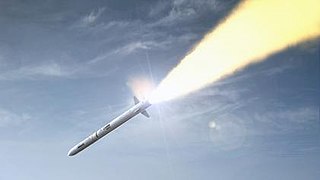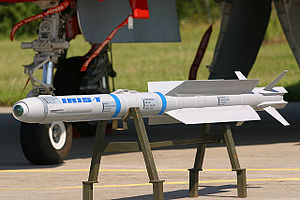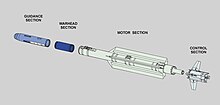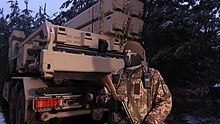The AIM-120 Advanced Medium-Range Air-to-Air Missile(AMRAAM) ( AM-ram) is an American beyond-visual-range air-to-air missile capable of all-weather day-and-night operations. It uses active transmit-receive radar guidance instead of semi-active receive-only radar guidance. When an AMRAAM missile is launched, NATO pilots use the brevity code "Fox Three".

The MIM-104 Patriot is a surface-to-air missile (SAM) system, the primary such system used by the United States Army and several allied states. It is manufactured by the U.S. defense contractor Raytheon and derives its name from the radar component of the weapon system. The AN/MPQ-53 at the heart of the system is known as the "Phased Array Tracking Radar to Intercept on Target," which is a backronym for "Patriot". In 1984, the Patriot system began to replace the Nike Hercules system as the U.S. Army's primary high to medium air defense (HIMAD) system and the MIM-23 Hawk system as the U.S. Army's medium tactical air defense system. In addition to these roles, Patriot has been given a function in the U.S. Army's anti-ballistic missile (ABM) system. As of 2016, the system is expected to stay fielded until at least 2040.

The Advanced Short Range Air-to-Air Missile (ASRAAM), also known by its United States designation AIM-132, is an imaging infrared homing air-to-air missile, produced by MBDA UK, that is designed for close-range combat. It is in service in the Royal Air Force (RAF), replacing the AIM-9 Sidewinder. ASRAAM is designed to allow the pilot to fire and then turn away before the opposing aircraft can close for a shot. It flies at well over Mach 3 to ranges in excess of 25 kilometres (16 mi). It retains a 50 g maneuverability provided by body lift technology coupled with tail control.

MBDA is a European multinational developer and manufacturer of missiles. It was created in December 2001 after the merger of the main French, British and Italian missile systems companies; Matra, BAe Dynamics and Alenia. These were previously the missile subsidiaries of Aérospatiale-Matra, BAE Systems and Finmeccanica. The company's headquarters are located in Le Plessis-Robinson, France.

The MICA, abbreviated from its full name Missile d'Interception, de Combat et d'Auto-défense or alternate translation is a French anti-air multi-target, all weather, fire-and-forget short and medium-range missile system manufactured by MBDA France. It is intended for use both by air platforms as individual missiles as well as ground units and ships, which can be equipped with the rapid fire MICA Vertical Launch System. It is fitted with a thrust vector control (TVC) system. It was developed from 1982 onward by Matra. The first trials occurred in 1991, and the missile was commissioned in 1996 to equip the Rafale and Mirage 2000. It is a replacement for both the Super 530 in the interception role and the Magic II in the dogfighting role.
The Medium Extended Air Defense System (MEADS) is a ground-mobile air and missile defense system intended to replace the Patriot missile system through a NATO-managed development. The program is a development of the United States, Germany and Italy.

The Flugabwehrkanonenpanzer Gepard is an all-weather-capable German self-propelled anti-aircraft gun (SPAAG) based on the hull of the Leopard 1. It was developed in the 1960s, fielded in the 1970s, and has been upgraded several times with the latest electronics. It has been a cornerstone of the air defence of the German Army (Bundeswehr) and a number of other NATO countries.

NASAMS is a distributed and networked short- to medium-range ground-based air defense system developed by Kongsberg Defence & Aerospace (KDA) and Raytheon. The system defends against unmanned aerial vehicles (UAVs), helicopters, cruise missiles, unmanned combat aerial vehicles (UCAVs), and fixed wing aircraft, firing any of a wide range of existing missiles.

The Mowag Eagle is a series of wheeled armoured vehicle designed by Mowag, a Swiss company now owned by GDELS.

Short range air defense (SHORAD) is a group of anti-aircraft weapons and tactics that have to do with defense against low-altitude air threats, primarily helicopters and low-flying aircraft such as the A-10 or Sukhoi Su-25. SHORAD and its complements, HIMAD and THAAD divide air defense of the battlespace into domes of responsibility based on altitude and defensive weapon ranges.

Diehl Defence GmbH & Co. KG is a German weapon manufacturer headquartered in Überlingen. It operates as a division of Diehl Stiftung and specializes in the production of missiles and ammunition.

The CAMM is a family of surface-to-air missiles developed by MBDA UK for the United Kingdom. CAMM is derived from, and shares some common features and components with, the Advanced Short Range Air-to-Air Missile (ASRAAM), but with updated electronics, a soft vertical launch system, and an active radar homing seeker. The CAMM family is either currently in-use or has been ordered by ten nations.

HensoldtAG(HENSOLDT) is a multinational corporation headquartered in Germany which focuses on sensor technologies for protection and surveillance missions in the defence, security and aerospace sectors. The main product areas are radar, optoelectronics and avionics. Hensoldt’s main office is in Taufkirchen near Munich, Germany.

CEA Technologies is an Australian defence contractor that primarily supplies the Royal Australian Navy. The company was established in 1983. Its phase array radars, which are fitted to the Royal Australian Navy's fleet of warships, are regarded as the best in the world.

The TRML is a family of air defense radars first developed by Telefunken and currently produced by Hensoldt. It is a development of the earlier TRMS.
MBDA UK is the British division of the pan-European missile systems company MBDA. Formed in 2001, the company has developed, both independently and in cooperation, a range of missile systems, including the CAMM missile family, Storm Shadow cruise missile, ASRAAM air-to-air missile and Meteor beyond-visual-range missile (BVRAAM).

The Joint Ground-based Air Defence Command is a joint command of the Royal Netherlands Army, formed in 2012 after amalgamation of the Commando Luchtdoelartillerie of the Royal Netherlands Army and the Groep Geleide Wapens of the Royal Netherlands Air Force. The command is responsible for all ground-based air defence tasks and consists of both army and air force personnel. The DGLC employs an integrated layered air-defence approach featuring FIM-92 Stinger, NASAMS II and MIM-104 Patriot systems.





























